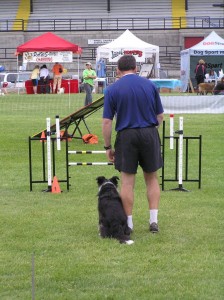

'One important key to success is self-confidence. An important key to self-confidence is preparation.' ~Arthur Ashe
Whether were are consciously aware of it or not, our human brains are great at finding cause for outcomes. When something happens to us, good or bad, we automatically attribute a reason for why it happened. Sometimes we are good at getting at the real cause, often we participate in some self-delusion. To boost our confidence, we want to take control of our attributions and shape them to enhance our self-confidence.
Here are a few examples of how different ways of thinking about “why” a performance happened makes a difference.
The Confident Athlete – Sam
After experiencing a successful performance, a smoking jumpers run in this case, Sam believes that all the extra work she recently put in on tightening her dog’s turns is responsible for the great run. She thinks that the turning work will continue to give her an advantage on course in future runs and that by having such a great run things are going to go great for the rest of the day.
Unfortunately for Sam, her next run, a standard course, didn’t go quite as well. A close call on the dogwalk contact cost her a clean run. On reflection, Sam thinks that her dog actually did a really good job on the faulted obstacle but the judge missed it and there’s nothing she could do about it. She makes a note in her journal to spend some time making her dog get deeper into the contact zone so it’s more obvious to judges not used to seeing her running contacts. Sam also believes that most other judges would have given her the clean run and that this event won’t have any impact on the rest of her day.
For Sam, the rest of her day goes well and she and her dog have a fun and exciting day playing together.
The Unconfident Athlete – Kathy
Kathy struggles quite a bit with her confidence. While she feels she and her dog have the skills to be a great team, they don’t seem to perform as well in competitions as they do in practice.
Kathy’s first run of the day is a challenging snooker run and unfortunately it didn’t go so well, getting whistled off before getting to the closing. Thinking about the her run, she feels that she doesn’t have the ability to do tough courses, especially games, and no amount of practice will change that. And of course, Kathy is dreading the rest of the day because she knows that this bad performance is going to bother her for all her other runs.
Now even with all that doom and gloom, Kathy’s next run goes really well. In her standard run, she manages to get through clean with a couple of close calls, especially on her A-frame contact. Thinking back on the run, Kathy feels that she was lucky to finish the run clean. Not all judges would have given her the contact call, and she was lucky again that she didn’t get called for any refusals. She believes that if she ran that course ten more times she wouldn’t have been able to pull it off. Kathy also thinks that her good fortune is temporary and won’t last beyond that run.
Needless to say, the rest of Kathy’s day was not as successful, and she left the competition in a pretty glum mood, wondering if she’ll ever be able to put it together.
Attribution & Confidence
Sam’s and Kathy’s thought process stand in stark contrast to each other. In the runs I described above, both handlers had one successful run and one unsuccessful run, however, the way that each person thought about the reason for the outcome was very different.
By manipulating or controlling this thought pattern, Sam is able to protect her confidence when she’s unsuccessful and enhance her confidence when she’s successful. Kathy does the exact opposite. She basically undercuts her confidence at every turn.
Here are some ideas you can use to become more like Sam and less like Kathy.
When you attribute cause to an outcome you need to consider three characteristics; control, stability, and influence.
In the unfortunate event of a bad performance, productive attributions will have the cause of the outcome be out of the performer’s control (e.g., bad luck), unstable (i.e., can easily be changed), and have limited to no influence on anything else (e.g., your next run).
For successful performances, improved confidence comes from attributing the outcome to something in the performer’s control (e.g., hard work), that is stable (i.e., will continue to occur), and has an influence on other areas (e.g., your next run).
Now that you know what to look for, spend the next trial thinking about your attributions. If you’re already making the right connections for both successful and unsuccessful runs, great, keep it up. If not, taking sometime before a competition to consider how you can “see” things the better way, can go a long way in getting you protecting your confidence when you’re unsuccessful and boosting your confidence when you are successful.
Happy Attributing 😉
Leave A Reply (3 comments so far)
The comments are closed.
Lynne Johnson
12 years ago
Thanks John,
I really appreciate the tidbits
Mary Turcin
12 years ago
I sound like Kathy, very uncanny. Thanks for reminding me what I need to work on.
Ninnie Lindvall
12 years ago
You make really good points. Thanks!